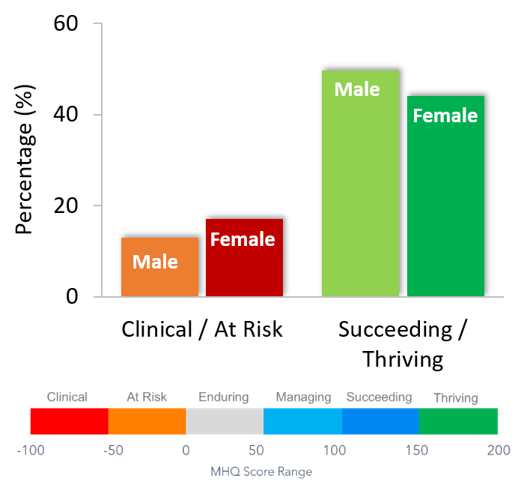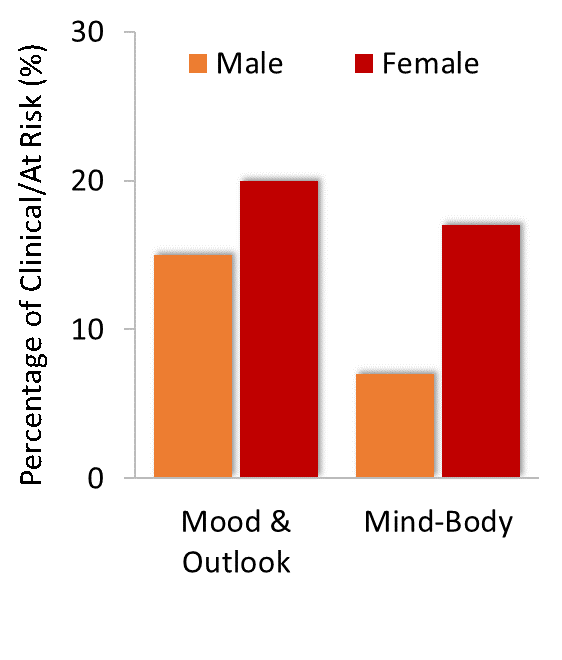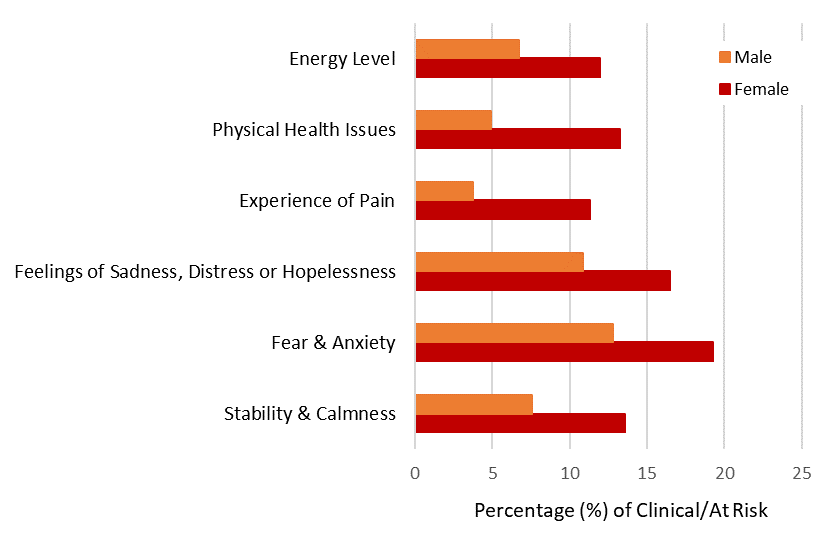Data from the Mental Health Million Project sheds light on the gender differences in mental health.
The American Psychiatric Association reports than one in five women have a mental health disorder. Women are also twice as likely to have post-traumatic stress disorder, generalized anxiety disorder, and panic disorders compared to men. Results from Sapien Labs’ Mental Health Quotient analysis shed light on how mental health differs between genders, especially in terms of how men and women experience symptoms.
MHQ Results
The analysis shows that a larger percentage of women scored in the At-Risk and Clinical categories compared to men (17% and 13%, respectively). Chart A also shows that more men fell into the Succeeding/Thriving categories compared to women.

Women also fared worse than men in two specific subcategories of mental health: Mood and Outlook and Mind and Body (Chart B).
- The Mood and Outlook subcategory describes how well a person manages their emotions, including feelings of fear, anxiety, anger, and sadness.
- Mind and Body describes someone’s ability to maintain mind-body balance so that their mental health challenges do not present as physical symptoms.

Chart B: Subcategory Differences by Gender
Both of these subcategories ask about many symptoms of clinical depression, which is twice as common in women as men.
Finally, Chart C shows specific gender differences in the Mood & Outlook and Mind-Body subcategories. A more significant percentage of women experienced physical health issues, pain, and lower energy levels. Women appear to experience more physical challenges than men, which is important to recognize when thinking about solutions.

Risk Factors for Women
Gender roles and expectations can increase stress levels for women, which puts them at higher risk for poor mental health outcomes. For example, 65% of women identify themselves as caretakers. Caretaking is traditionally seen as a female role. However, the constant stress and pressure from caretaking can negatively impact women’s well-being.
Also, gender-based violence impacts women’s mental health, and this type of abuse is more common than many people realize. One in three women has experienced sexual violence, physical violence, or stalking behavior in their lifetimes. Sexual violence, in particular, is closely related to higher PTSD rates in women.
Finally, lower socioeconomic status can contribute to poorer mental health in women. Financial concerns can increase stress levels, which can prompt or exacerbate depression and anxiety. In the U.S., women still make only $0.78 to every dollar a man makes, and women are more likely to live at or below the poverty line. It is vital to address all of these risk factors when developing gender-specific policies and programs.
Mental Health in Men and Transgender/Non-binary People
While the occurrence rate may be higher in women, men also struggle with mental health issues, and gender expectations may be a factor. According to the Office on Women’s Health, men often do not seek help for depression because they believe it makes them look weak.
Men’s symptoms of depression (anger and aggressiveness) also look different than women’s, which can make it harder to diagnose depression in men. However, the consequences of overlooking men’s mental health are dangerous; men were over five times more likely to die by suicide compared to women in 2018.
Also, transgender and non-binary individuals face serious mental health challenges. A recent study from Boston University found that 78% of “gender-minority” students met the criteria for at least one mental illness. The MHQ currently does not have enough data to analyze the well-being of trans/non-binary people, but Sapien Labs recognizes the importance of including this group in gender-based analyses.
Policy Interventions
Population data can show healthcare leaders how mental health and well-being presents itself across all genders. Policymakers and their partners can use this information to create targeted gender-based mental health policies or programs.
Some states have taken action to increase women’s access to mental health care. For instance, California Gov. Gavin Newsome allocated $8.6 million of state funds to support women with maternal mental health problems. South Carolina also extended health insurance coverage for mothers by asking the federal government to fund healthcare insurance for 12 months post-partum.
On a broader scale, the National Council of State Legislatures suggests specific policy actions for states to improve women’s mental health:
- Increase access to services, including considering telehealth as an option
- Address public policies that are unintentionally creating barriers to services
- Establish a task force to study women’s mental health and generate suggestions to improve treatment
Using population-based data, all of these actions can be taken at the local, state, and national level to improve mental health and well-being of all citizens.


















